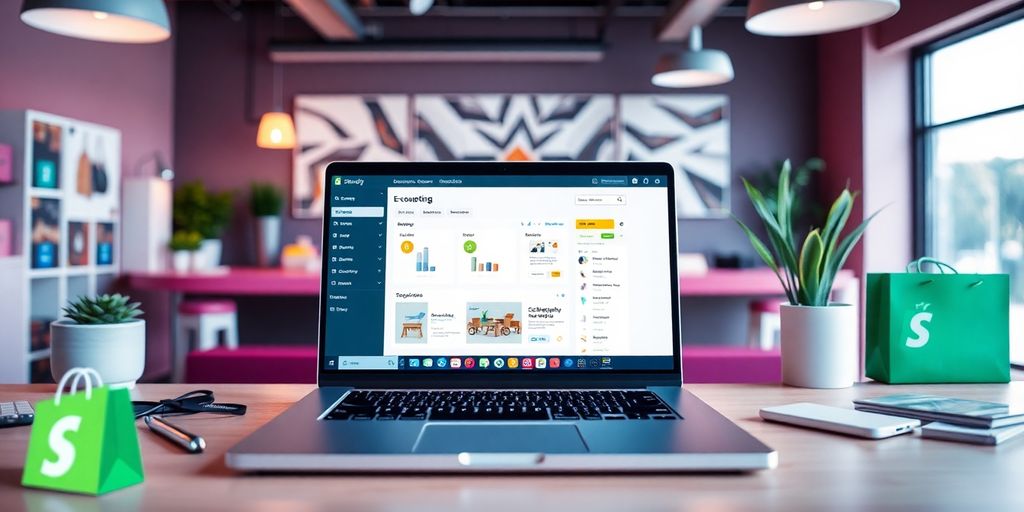Alright, let's chat about Shopify's Admin API GraphQL. If you're into e-commerce, this is one tool you don't want to ignore. It's like having a secret weapon for your online store, helping you tweak and tune things just the way you want. Whether you're building custom themes or crafting public apps, this API opens up a world of possibilities. And if you're aiming to boost your sales numbers, well, you're in the right place. Let's break it down and see what makes this API tick.
Key Takeaways
- Shopify Admin API GraphQL is a must-have for e-commerce innovation.
- Setting up involves a few steps: configuration, authentication, and permissions.
- Custom themes and apps can be built using GraphQL for a unique store experience.
- Optimizing with GraphQL can lead to higher order values and better user interactions.
- Stay updated on API trends to keep your store ahead of the curve.
Understanding Shopify Admin API GraphQL
What is Shopify Admin API GraphQL?
Alright, let's break it down. The Shopify Admin API GraphQL is like the backstage pass to your Shopify store. Instead of dealing with the usual REST API, GraphQL lets you ask for exactly what you need and nothing more. This means you can pull specific data from your store, whether it's product details, order info, or customer data, without overloading your system with unnecessary information.
Key Features of Shopify Admin API GraphQL
Here's the cool part about GraphQL:
- Efficiency: You only get the data you ask for. No more, no less.
- Flexibility: You can fetch multiple resources in a single request. No need to make several calls.
- Strong Typing: With GraphQL, you know exactly what data structure to expect, which makes it easier to debug and maintain.
Benefits of Using Shopify Admin API GraphQL
Why should you care about using GraphQL? Well, there are some solid reasons:
- Performance Boost: By reducing the amount of data transferred, your app runs faster.
- Simplified Code: Fewer API calls mean cleaner and more maintainable code.
- Enhanced User Experience: Faster load times and tailored data retrieval mean happier customers.
Using Shopify Admin API GraphQL can really streamline your e-commerce operations. It's like having a superpower that lets you customize and optimize your store's backend without all the extra fluff. If you're aiming for a more efficient and responsive store, this is your ticket.
Setting Up Your Shopify Admin API GraphQL
Initial Setup and Configuration
Getting started with Shopify Admin API GraphQL is like assembling a new piece of furniture. You need to gather all the right parts and follow the instructions carefully. First, make sure your Shopify store is ready for API access. You will need to create a private app in your Shopify admin panel. Here’s a quick rundown of what you need to do:
- Go to your Shopify admin and click on "Apps".
- Scroll down and hit "Manage private apps".
- Click "Create a new private app" and fill in the details.
Once you’ve set up your private app, you’ll receive an API key and password. Keep these safe—they’re your keys to the kingdom.
Authentication and Permissions
Now, let’s talk about getting the right permissions. You don’t want your app to have more access than it needs. When setting up, you’ll be prompted to select the permissions for your API. Choose only what is necessary for your project. For example, if you’re just dealing with orders, don’t check the box for customer data. This not only keeps things secure but also makes your API requests faster.
Remember, the Shop resource is tied to the access token you use, which includes business and store management settings. Keep your tokens secure!
Common Setup Pitfalls and How to Avoid Them
Setting up isn’t always a smooth ride. Here are some common hiccups and how to sidestep them:
- Incorrect Permissions: Double-check that you’ve selected the right permissions. Missing one can lead to errors later.
- Expired Tokens: Tokens can expire. If you’re getting authentication errors, this might be why.
- API Versioning: Shopify updates its API regularly. Make sure you’re working with the correct version to avoid compatibility issues.
Setting up your Shopify Admin API GraphQL might seem daunting at first, but with a little patience and careful planning, you’ll be ready to unlock its full potential.
Leveraging Shopify Admin API GraphQL for Custom Solutions
Creating Custom Themes with GraphQL
When you're working on Shopify, creating custom themes is a fun way to make your store stand out. Using GraphQL, you can fetch exactly the data you need to make your themes dynamic and responsive. Imagine being able to pull in live product data or customer reviews directly into your theme—how cool is that? Here’s a quick breakdown of what you can do:
- Dynamic Content: Fetch and display live product details.
- Personalized Experiences: Tailor content based on user data.
- Efficient Updates: Update themes without reloading the entire page.
Building Public Apps Using GraphQL
Building public apps with GraphQL on Shopify is like having a superpower. You get to create apps that can be used by any Shopify store, opening up a world of possibilities. Whether it’s an app for inventory management or customer engagement, GraphQL helps you fetch data quickly and efficiently.
- Data Fetching: Retrieve only the data you need, reducing load times.
- Scalability: Easily scale your app as more users start using it.
- Flexibility: Adapt your app to meet various store needs.
Innovative Checkout Upselling Tools
Upselling at checkout is a great way to boost sales, and with GraphQL, you can make this process even smoother. Imagine suggesting complementary products or offering discounts right at the checkout page. Here’s how you can do it:
- Real-Time Suggestions: Use customer data to make personalized recommendations.
- Discount Integration: Offer discounts on upsell items seamlessly.
- User-Friendly Interface: Keep the checkout process quick and easy.
Pro Tip: When transitioning from REST API to GraphQL, start by exploring GraphQL resources and operations to understand the basics before making the switch. This will save you a lot of headaches later on.
By using Shopify Admin API GraphQL, you're not just creating a store; you're crafting a unique shopping experience that can adapt and grow with your business.
Optimizing E-commerce with Shopify Admin API GraphQL
Boosting Average Order Value (AOV)
Alright, so you're running an online store and want to get more bang for your buck, right? Boosting your Average Order Value (AOV) is a great place to start. With Shopify Admin API GraphQL, you can create personalized recommendations and upsell offers that make sense to your customers. Imagine suggesting complementary products right when they're about to check out. That's a smart way to increase sales without needing more customers. You can use bulk operations in Shopify's GraphQL API to handle these tasks efficiently, saving time and resources.
Enhancing User Experience
Let's talk about user experience. It's all about making shopping on your site as smooth as possible. With GraphQL, you can pull just the data you need, making your site faster and more responsive. Nobody likes waiting around for pages to load, right? You can also customize the shopping journey, tailoring it to what your customers really want. Think of it like setting up a store where everything is right where it should be, and customers feel at ease.
Increasing Conversion Rates
Conversion rates are the bread and butter of e-commerce. You want visitors to your site to become buyers, not just window shoppers. By using Shopify Admin API GraphQL, you can streamline the checkout process, reducing the steps needed to make a purchase. This makes it easier for customers to say "yes" to buying. Also, you can analyze customer behavior, tweaking your approach based on what works and what doesn't. It's all about making the shopping experience so good that people can't resist hitting that "buy" button.
When you focus on optimizing these aspects of your e-commerce site, you're not just selling products—you're building a relationship with your customers, making them want to come back for more.
Best Practices for Shopify Admin API GraphQL
Efficient Query Structuring
When you're working with Shopify Admin API GraphQL, structuring your queries efficiently can save you a lot of time and headaches. Think of it like packing a suitcase: you want everything to fit neatly without leaving out the essentials. Avoid over-fetching data you don't need, as it can slow down your app and increase your API call count. Instead, focus on getting just the right amount of information. Here's a quick checklist to keep in mind:
- Identify exactly what data you need before writing your query.
- Use fragments to keep your queries tidy and reusable.
- Regularly review and optimize your queries as your app grows.
Handling API Rate Limits
No one likes hitting a wall, especially not when you're in the middle of coding. Shopify's API comes with rate limits, so it's important to know how to work within them. You can check out effective strategies for implementing rate limits to make sure you're not caught off guard. Consider these tips:
- Monitor your API usage to stay within limits.
- Implement exponential backoff strategies for retries.
- Batch requests where possible to minimize the number of API calls.
Ensuring Data Security
Data security is like locking the front door before going to bed—it's a must. When working with Shopify Admin API, always keep security at the forefront. Here are some pointers:
- Use HTTPS to encrypt data in transit.
- Regularly update your access tokens and keep them secure.
- Limit access to sensitive data by setting appropriate permissions.
Keeping your data secure isn't just about protecting your business; it's about maintaining trust with your customers. They rely on you to keep their information safe, so make it a priority.
By following these best practices, you'll not only improve the performance of your Shopify store but also ensure a smoother experience for your users. Remember, a little effort in structuring queries, managing rate limits, and securing data can go a long way in enhancing your e-commerce solutions.
Troubleshooting Common Issues in Shopify Admin API GraphQL

Debugging GraphQL Queries
So, you're knee-deep in code, and your GraphQL query just isn't working. Frustrating, right? First things first, double-check your syntax. GraphQL is pretty strict about its structure. A missing bracket or typo can throw everything off. Also, make sure you're requesting fields that actually exist in the schema. If you ask for something that's not there, you'll get an error.
Remember, the error might not always be obvious. Sometimes, it's about the data types or the way you're nesting fields. Take a step back and review your query structure.
Resolving Authentication Errors
Authentication issues are another common headache. If you're getting denied access, check your API keys and tokens. They need to be up-to-date and have the right permissions. Here's a quick checklist:
- Verify your API key and secret.
- Ensure your app has the necessary permissions.
- Check if your token has expired.
If you still face issues, it might be worth regenerating your tokens and trying again.
Overcoming Performance Bottlenecks
Performance can be a killer, especially when you're dealing with large datasets. If your queries are slow, consider these tips:
- Optimize your queries by fetching only the data you need. Avoid pulling in unnecessary fields.
- Use pagination to handle large datasets efficiently.
- Cache responses where possible to reduce load times.
And if you're getting an error related to non-existent fields like notifyCustomer, it might be time to revisit your queries and ensure you're only asking for what's available.
In the end, patience and a systematic approach will help you tackle these common issues. Keep experimenting and learning, and you'll get the hang of it.
Future Trends in Shopify Admin API GraphQL

Emerging Features to Watch
Shopify's GraphQL Admin API is always evolving, and there are some exciting features on the horizon. Starting April 1, 2025, all new apps submitted to the Shopify App Store must utilize the GraphQL Admin API, while existing apps can continue using the REST API. This shift indicates Shopify's commitment to GraphQL's efficiency and flexibility. Expect more tools that improve data fetching and schema management, making it easier for developers to create robust e-commerce solutions.
Integrating AI with GraphQL
AI integration is becoming a hot topic in the tech world, and Shopify is no exception. With AI, you can personalize shopping experiences like never before. Imagine using machine learning to analyze customer behavior and adjust your store's offerings in real-time. This could mean smarter product recommendations or even dynamic pricing strategies that respond to market changes instantly.
The Future of E-commerce Solutions
The future of e-commerce is all about customization and efficiency. With GraphQL, developers have more control over the data they work with, which can lead to more personalized shopping experiences. Think about custom themes that change based on a user's preferences or checkout processes that adapt to different user needs. As technology advances, expect to see even more innovative solutions that make online shopping smoother and more enjoyable.
The shift towards GraphQL in Shopify's ecosystem reflects a broader trend in tech: the move towards more efficient, flexible, and developer-friendly APIs. As these technologies continue to grow, they'll open up new possibilities for creating unique and engaging online shopping experiences.
As we look ahead, the Shopify Admin API GraphQL is set to change the way online stores operate. This new technology will make it easier for developers to create apps that help merchants manage their shops more efficiently. With features like faster data retrieval and better integration, businesses can expect to see improvements in their operations. If you're interested in learning more about how these trends can benefit your store, visit our website for more insights!
Wrapping It Up
Alright, so we've covered a lot about using Shopify's Admin API with GraphQL. It's like having a secret weapon for your online store. By now, you should have a good idea of how to make your e-commerce game stronger. Whether you're tweaking your store's look or boosting sales with smart upsell tactics, this API is your friend. Just remember, it's all about making things easier for your customers and giving them a smooth shopping experience. So, go ahead, dive in, and start experimenting with what you've learned. Your store's success is just a few clicks away!
Frequently Asked Questions
What is Shopify Admin API GraphQL?
Shopify Admin API GraphQL is a tool that lets you manage your online store more easily. It helps you get and change data quickly, making your store run better.
Why should I use Shopify Admin API GraphQL?
Using Shopify Admin API GraphQL can make your store faster and more flexible. It helps you create custom solutions that fit your business needs.
How do I set up Shopify Admin API GraphQL?
To set it up, you need to configure your store settings and ensure you have the right permissions. Follow the setup guide provided by Shopify to get started.
What are some common problems with Shopify Admin API GraphQL?
Some common issues include authentication errors and performance bottlenecks. Make sure to follow best practices to avoid these problems.
How can I improve my store with Shopify Admin API GraphQL?
You can boost your store by creating custom themes, building apps, and using upselling tools to increase sales during checkout.
What are the future trends for Shopify Admin API GraphQL?
Future trends include new features, AI integration, and more advanced e-commerce solutions. Staying updated will help you take advantage of these innovations.


